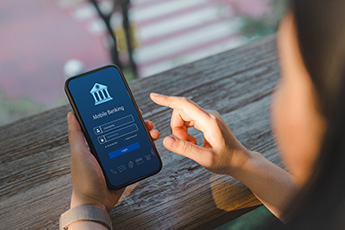July is known as Independent Retailer Month. This campaign to celebrate small, local businesses became a global effort in 2011. The originators, Tom Shay and Kerry Bannigan, sought to engage retail associations, chambers of commerce, and other entities with local impact to encourage locals to spend within their communities and recognize the impact that all merchants have on their local economy.Of course, local businesses have very different needs than their larger counterparts when it comes to business expenses. For instance, some small businesses — like those that provide services rather than goods, freelancers, or home businesses — may not require a loan to fund inventory, a factory, or a place of business. But that doesn’t mean they don’t have crucial financial needs to help keep their business flowing. For those businesses, mobile banking is one of the most valuable tools your financial institution can provide. However, some community financial institutions (CFI) don’t offer mobile banking at all, while others have limitations and restrictions around its use. Mobile banking, especially mobile deposit, might be a factor that determines where small- and medium-sized business (SMB) owners do their business banking. Building and enhancing mobile banking capacity can help attract SMB customers from anywhere in the country — and if these businesses ever need credit, their existing financial institutions will likely be first in line to provide it.SMBs love mobile banking, and with good reason.A 2019 survey from J.D. Power found that small business interest in mobile banking was growing rapidly. At the time, 61% of SMB customers used their financial institution’s mobile app, an increase from 53% the previous year. During the pandemic, when branch banking was difficult, mobile banking provided a lifeline to the small businesses that rely on making daily deposits and withdrawals. According to a Raddon survey, 57% of CFIs’ business customers use mobile apps at least monthly.It seems that mobile banking and other digital banking services are significant factors in the decisions these businesses make about where to bank. About three-quarters of small businesses have a primary financial relationship with one of six major banks: Bank of America, JPMorgan Chase, Wells Fargo, PNC Bank, U.S. Bank, and Truist. Of those business customers, 41% conduct most of their business using online, mobile, or ATM banking. Roughly 30% of businesses that use a major bank say that the provider’s technology resources were a factor in their choice of financial services providers. In line with that statistic, 27% of big bank business customers would switch to a CFI, if it offered them the same technological capabilities.All these numbers point to a single fact: SMBs are growing users of mobile banking. It saves them significant amounts of time, lets them bank at whatever time of day works best for them, and allows them to choose the institution they want, rather than choosing the bank that’s closest to them. Saving time and choosing a financial services provider based on factors other than convenience is particularly important for rural businesses and those located in small towns, where a variety of banking options aren’t close at hand. Simply put, small businesses are increasingly gravitating toward wherever the best mobile banking tools are.Offering Mobile Banking to SMBs Can Help Grow Your Relationship.Making customers happy is a good reason for a CFI to adopt mobile banking, but the offering has additional benefits for a financial institution. Mobile banking fosters deeper relationships between CFI and SMB customers and increases the likelihood that the customer will stay with the CFI. In fact, mobile banking greatly increases satisfaction among SMB owners. Customer satisfaction scores were 43 points higher for those who used mobile banking tools than those who didn’t. Not only can offering mobile apps to business customers help retain customers, but it can also make expanding a relationship with these customers far more likely. About two-thirds of SMB customers who have used their financial institution’s mobile app indicated that they’d definitely go to the same institution for further financial needs. Further, SMB customers that use mobile banking are usually growing, with 71% SMBs who use mobile banking classified as high-growth. Growth means that these businesses are likely to need loans, make larger deposits, and require other business services.By adding mobile banking to their list of customer offerings, CFIs can help customers save time, expand their options, and manage cash flow, while also creating deeper relationships with businesses that are likely to need loans, make larger deposits, and purchase other business services.

BID® Daily Newsletter
Jul 25, 2023
BID® Daily Newsletter
Jul 25, 2023

Mobile Banking Is a Crucial Tool for Small Businesses
Summary:
For small businesses that don’t need a loan, mobile banking is one of the most valuable tools a CFI can provide. It lets customers bank where they want, whenever they want. In addition to providing customer convenience, mobile banking can also help your institution to increase loans and deposits, and sell other business services.
Subscribe to the BID Daily Newsletter to have it delivered by email daily.
Related Articles:

Building Stronger Bonds in Small Business Lending
Per tradition, we're looking back on our top articles of the year to BID goodbye to 2025. In this January article, the FDIC’s 2024 Small Business Lending Survey reaffirms the importance of relationship-driven lending for CFIs.
Per tradition, we're looking back on our top articles of the year to BID goodbye to 2025. In this January article, the FDIC’s 2024 Small Business Lending Survey reaffirms the importance of relationship-driven lending for CFIs.

The Best Banking Apps Increase Customer Touchpoints by 51%
Mobile banking leaders have 2.3x as many customer interactions as their competitors. We dive into the key elements that separate the best banking apps from the rest.
Mobile banking leaders have 2.3x as many customer interactions as their competitors. We dive into the key elements that separate the best banking apps from the rest.
